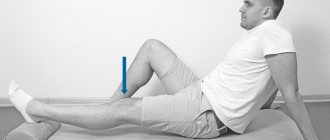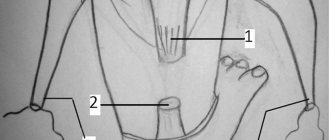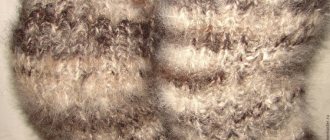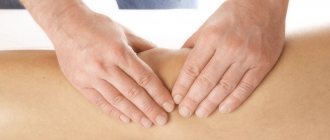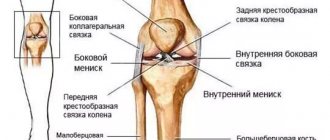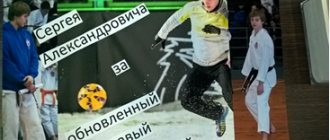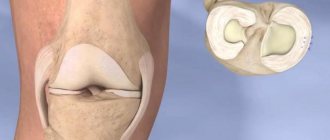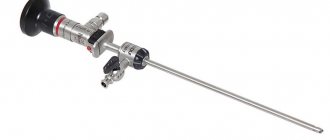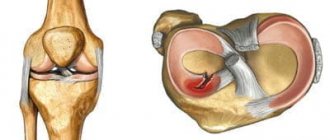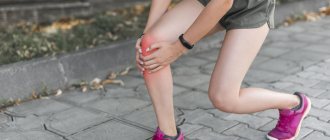The largest, most complex and vulnerable components of the musculoskeletal system in humans are the knee joints. They are often exposed to injuries of various origins - blows, bruises, sprains, meniscus damage, etc. Frequent injuries can lead to the development of degenerative diseases in which cartilage tissue is destroyed.
Sometimes it is enough to immobilize the sore spot to feel relief. A knee brace for fixing the knee joint will help to evenly distribute the load on all parts of the joint. The functionality of the limb is not impaired, all metabolic processes and blood circulation do not change, and negative changes and tissue death slow down.
Orthoses for fixing the knees are suitable for the prevention, protection and treatment of the joint from various traumatic injuries, and are also used during the rehabilitation period after serious illnesses or operations.
Open and closed knee pads
Elastic closed-type knee pad with stiffening ribs.
Knee pads for joints are distinguished by several indicators: design, manufacturer, materials. They can be open and closed, elastic and rigid, with hinges and metal inserts, and have magnetic plates or silicone rings.
A closed-type orthopedic knee brace covers the entire knee, partially covering the leg from below and from above. Soft all-round fixation of the joint allows you to maintain all parts of the kneecap in an anatomically correct position.
The use of a closed type bandage leads to a decrease in swelling and inflammation, ease of motor functions and a decrease in pain intensity.
For mild forms of gonarthrosis, open-type knee pads with tension adjustment are used. The kneecap in such braces is not closed, and the location of the elastic tightening bands under and above the knees is secured with Velcro. Such bandages are used in the postoperative period for joint inflammation. You can maintain the desired knee position by adjusting the tension of the bands while reducing swelling.
A simple version of a knee brace is a special strap design that is attached under the knee, which helps support the ligaments and reduces pain.
Types of fixing products
For the early stages of arthrosis and the postoperative period, the use of a dynamic knee brace .
The presence of rigid and moving parts in its design guarantees weak knee locking with simultaneous massage when walking. People who are subject to acute pain accompanied by limited movement and difficulty going up and down stairs will benefit from a knee brace with a spiral frame . In the manufacture of knitting needles and spirals for this type of retainer, medical steel is used. By removing the stiffeners, you can adjust the fixation force. Such orthoses significantly reduce the load on the knees when walking.
The bandage with rigid metal hinges has a hole in the knee area and is fixed with elastic bands. Used at different stages of treatment. The disadvantage of the knee pad is its size: it is problematic to hide it under clothes.
The most rigid design of a splint is a knee brace with several degrees of fixation. Reliable fastening, in which the patient’s joint is completely immobilized, is used in case of knee injury. For minor defects and pain in the joint, a medium-strength fastening is used. To prevent possible damage, a weak splint is necessary. These knee pads are made from soft hypoallergenic materials.
Brace is a fixing knee pad with additional hardness ribs and hinge joints. It is an alternative to a plaster cast for fractures and at the postoperative stage. Adjusting the degree of knee flexion allows the patient to attend exercise therapy classes with little load on the knee. The orthosis is easy to apply, it is easy to use, unpretentious in maintenance, and at the same time perfectly secures and holds the knee joints.
Neoprene open knee caliper
A caliper is sufficient to support the menisci and collateral ligaments . It is useful for those who actively play sports or spend a lot of time on their feet. Used while jogging or training to prevent sprains and injuries. The support is an invariable attribute of professional athletes.
The tape has a sticky coating. When applied correctly, it does not impede the work of the joint and does not put pressure on it; it massages the skin under the bandage. It is most often made from cotton fabrics.
An elastic bandage is used to prevent defects in knee joints: fixing sprains, bandaging bruises and other minor injuries. The disadvantage of the bandage is that it does not fit well on the knee and requires regular dressings. In addition, the force of tightening the knee joint with a bandage is difficult to calculate: bandaging too tightly can disrupt the blood circulation process, which will result in swelling or temporary numbness of the leg; weak fixation will not have the desired effect. They are rarely used, preferring more modern and functional analogues.
A heated medical is used at different stages of gonarthrosis. Exposure to dry heat promotes cartilage repair. In a heated joint, there is an increase in elasticity, ligament mobility, and a decrease in pain. The heating element in the form of a fiber is built into the elastic covering the retainer. The patient selects the strength of uniform heat distribution over the knee joint independently. For chronic patients, such orthoses are simply irreplaceable.
Nanomaterials containing tourmaline exhibit thermoelectric and piezoelectric effects on the knee joint. The magnetic field and infrared radiation accelerate the regeneration of cartilage in the knee. A significant effect of such knee pads is observed when used in the early stages of arthrosis.
Causes of meniscus tear
Factors that trigger cartilage rupture include the following.
- Injuries of any nature, including sports.
- Sudden movements with the lower leg moving to the side.
- Sudden extension movements involving the knee.
- Age-related changes associated with a decrease in calcium in bones and other degenerative processes after 55 years.
Most often, young people under forty turn to specialists with such injuries. They are more susceptible to injury due to an active lifestyle, sports, heavy physical work, and so on. This type of injury is rare in children.
In older patients, meniscal tears are caused by excessive stress, falls, and other sudden movements. The rupture occurs due to changes in the structure of cartilage and bone tissue. It becomes porous, loses its elasticity and is more susceptible to damage.
The types of meniscal tears are as follows.
- Full or partial.
- Isolated or combined.
- With displacement of the torn part of the meniscus: horizontal, degenerative, with damage to the structures of the meniscus.
Meniscus tears have their own markings in ICD-10 codes depending on the timing of the injury.
- S83.2 is a code that includes a recent meniscus injury.
- M23.2 – code for a meniscus tear resulting from old injuries.
Meniscal tears account for more than 70% of all knee injuries.
Knee pad materials
Knee pads made of various materials
The most pleasant for the body are cotton braces: they breathe, regulate moisture, and do not cause irritation. However, for all their advantages, they are impractical to use: they get dirty quickly, and more often than others, they become deformed when washed.
The neoprene elastic knee pad perfectly binds and warms the knee joints. It washes perfectly and does not deform when drying. However, such a bandage practically does not allow air to pass through and does not absorb moisture, so the risk of developing skin infectious and allergic diseases is very high. If, however, preference is given to such a retainer, a layer of cotton fabric between the body and the bandage will help to avoid undesirable consequences.
An elastane bandage will provide a reliable fixation. Elastane threads are rarely used in their pure form. More often they are combined with cotton fibers, which allows the fabric to maintain its structure when applied and breathe.
High-strength nylon and polyester are also not used in their pure form. Elasticity, safety in terms of health and hypoallergenicity are possible when their fibers are combined with threads of other types of fabric. Spandex knee pads are highly breathable and do not cause negative emotions when used. They are practically invisible under clothing, as they fit very tightly to the leg.
Knee pads made of natural dog hair have an analgesic effect, cause blood flow to the inflamed area, and remove static electricity accumulated on the skin. Camel wool has the same properties: moisture absorption, air permeability, heat retention, static electricity removal. Animal fat contained in wool, when heated, nourishes the skin and relieves inflammation. The disadvantage of wool knee pads is that upon contact with the skin, an allergy may occur in the form of a rash. The service life of such products is short.
Children's restraints are most often made to order, using various materials and designs. For children diagnosed with cerebral palsy, a special elastic fixing knee brace facilitates the procedure of movement.
Rehabilitation after a meniscus tear
The therapy required requires rehabilitation to ensure rapid restoration of mobility in the knee. The procedures used during the rehabilitation process are aimed at restoring tissue inside the damaged area. The following methods may be used.
- Physiotherapeutic procedures.
- Ultrasound.
- Physical therapy training.
- Wearing special knee pads.
All methods can be used either in combination or separately from each other, depending on the degree of damage.
Limitations when using fasteners
It is not recommended to use knee pads for thrombophlebitis.
The knee pad, like other medications, has limitations in its use. For patients with poor circulation, this attribute is prohibited. People with a history of thrombophlebitis or varicose veins will also not be able to use the fixative.
For allergy sufferers and patients with skin inflammation, a bandage will be prescribed only after the irritation has subsided.
Benefits of knee orthoses
- Meniscus injuries are usually associated with inflammation and pain. Using bandages helps reduce the impact of these factors on your well-being.
- The product partially limits the mobility of the joint, reducing the range of possible positions of the articular structures, which creates favorable conditions for the restoration of cartilage.
- The retainer is easy to use: it can be removed and put on without assistance at any time.
- Knee orthoses for meniscal injuries are made from high-tech materials that avoid chafing, diaper rash, and allergic spots.
- The product does not require special care and can be stored for a long time without loss of quality. Simply wash it in warm soapy water and dry it in a dark, dry place.
How to choose a knee pad
To choose the right fixation product, you should seek advice from a qualified orthopedic specialist. The brace must be proportionate to the knee. A knee brace that is too small can put pressure on the joint and cause more harm than good. A knee pad that is too large will not stay on your leg.
An ideal orthosis fits the leg tightly at the knee, fixing the joint without squeezing it.
How to determine the size of the retainer
Measuring the circumference of the knee
To determine the size of the brace, you need to measure 15 cm from the middle of the knee up the thigh and determine the volume of the leg in this place. Measurements should be taken while standing, with the leg straight and relaxed.
With a hip circumference up to 44 cm - size S, 44 - 54 cm corresponds to size M, 54-60 cm - size L, 60-67 cm - size XL, hip volume over 67 cm corresponds to size XXL. A size chart is included with each knee pad.
The selected knee pad must be tried on, because products in this category are not eligible for returns or exchanges. It is better to make a purchase in a specialized store or pharmacy. Asking for a quality certificate is in the buyer’s interests, since a low-quality knee brace can be harmful to health.
The instruction manual attached to each orthopedic product will tell you how to prolong its therapeutic and preventive qualities. Washing with a washing machine followed by ironing can lead to a complete loss of the properties and qualities of the fixative. To avoid deformation, the product does not need to be stretched or hung when drying. It is not recommended to soak it in products containing chlorine.
Which manufacturers can you trust?
Knee brace Genu Direxa Stable
The market for orthopedic braces represents quite a lot of manufacturers who develop and produce high-quality products:
- Orlett are products made by German orthopedic fashion designers that follow the silhouette of the leg and properly block the knee joint. Orthoses, made of cutting-edge materials with provided stiffening ribs, support the muscles and ligaments of a person. Knee pads are breathable and do not cause allergies.
- Nebat is the only company from Turkey that produces insulating knee pads made from dog hair. Thin products are indistinguishable under clothing, but at the same time they warm and relieve leg fatigue.
- Fosta - presents a wide range of therapeutic knee pads of different lengths and widths. The company's branches are open in 34 EU countries and cooperate with more than 2 thousand commercial organizations around the world. The largest reliable supplier of modern orthopedic products to the Russian market.
- Medi is a German company representing world leaders in the development and production of medical compression hosiery and prosthetic and orthopedic products. High quality products are presented in 125 countries. medi Orthopedics products are effective and safe.
- Orto is a Russian trading and manufacturing company of orthopedic products. All products are certified. Fasteners of this brand are also produced in Germany, Spain and the countries of Southeast Asia under original contracts.
- TOROS-GROUP is a Ukrainian manufacturing company for the production of orthopedic products.
The most popular knee pads among consumers are:
- Genu Carezza is a semi-rigid retainer. Use is indicated at the primary stage of arthrosis and gonarthrosis with increased load on the knee joint.
- Drytex economy hinged is a bandage with a strong degree of fixation. Designed for people with weakened lateral menisci.
- Genu Direxa Stable is a semi-rigid knee orthosis. Necessary during rehabilitation measures at the postoperative stage. Relieves pain syndromes well.
What determines the price of an orthopedic product?
Many factors influence the pricing of a product: manufacturer’s brand, quality and type of materials, design features. The price gap is quite large - from 30 to 300 dollars. The simplest knee brace will cost about 1000 rubles. An orthopedic knee brace that stabilizes the knee joint is somewhat more expensive - from one and a half to two thousand rubles.
The most expensive are modified knee pads with hinges; their price can exceed 25,000 rubles.
All users are unanimous in one thing: you should not buy a cheap analogue of an expensive brand. The service life of such products is usually short, and the fixing force is insufficient.
The quality of an orthopedic fixator is determined by:
- perfect repetition of the contour of the joints;
- internal seam condition: high quality products have seams with a smooth and flat surface;
- comfort in use.
